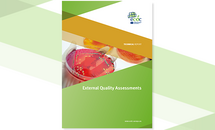Fourth external quality assessment on species identification and antimicrobial susceptibility testing of Campylobacter, 2018
This report presents the results of the fourth round of the EQA on antimicrobial susceptibility testing (AST) for national public health laboratories for Campylobacter (Campylobacter EQA4-AST) within the Food‐ and Waterborne Diseases and Zoonoses Network (FWD-Net). The objectives of this EQA4-AST were to determine the accuracy of quantitative AST results reported by participants; to identify common laboratory problems related to the guidance in the EU protocol, and to assess the overall comparability of routinely collected AST data from national public health reference laboratories across Europe.
Executive Summary
Since 2008, the EU/ EEA countries have been able to report antimicrobial resistance (AMR) data to the European Surveillance System (TESSy) as part of the routine surveillance data for salmonellosis and campylobacteriosis. In 2014, ECDC published an EU protocol for harmonised monitoring of AMR in human Salmonella and Campylobacter isolates (updated in 2016). In addition, ECDC launched an external quality assessment (EQA) scheme for antimicrobial susceptibility testing (AST) for Salmonella and Campylobacter to support the implementation of the EU protocol in the EU Member States and EEA countries and to get an overview of the quality of the AMR data reported to ECDC.
This report presents the results of the fourth round of the EQA on antimicrobial susceptibility testing (AST) for national public health laboratories for Campylobacter (Campylobacter EQA4-AST) within the Food‐ and Waterborne Diseases and Zoonoses Network (FWD-Net). The objectives of this EQA4-AST were to determine the accuracy of quantitative AST results reported by participants; to identify common laboratory problems related to the guidance in the EU protocol, and to assess the overall comparability of routinely collected AST data from national public health reference laboratories across Europe.
The Campylobacter EQA4-AST covered species identification and AST in Campylobacter spp. Twenty-two national public health reference laboratories in the EU/EEA participated in the EQA that took place during the period March to December 2018. In addition, six EU candidate/potential candidate countries (EU enlargement countries) participated in the EQA. This report focuses only on the results and evaluation from the EU/EEA countries.
Strains for the EQA were selected according to their current relevance to public health in Europe and shipped to the participating laboratories. Participation in the EQA involved testing and reporting on three mandatory antimicrobials (ciprofloxacin, erythromycin and tetracycline), with an option to report on an additional antimicrobial, gentamicin. Test results from all participants were evaluated and individual feedback provided.
The test results for antimicrobial susceptibility were analysed using two different approaches. The laboratories reported their results as disk diffusion (DD) and minimum inhibitory concentration (MIC) values that were compared to the value established by the EQA provider, either by calculating mm difference for disk diffusion values or number of dilution differences for minimum inhibitory concentration values. Reported quantitative results were further interpreted as wild type or non-wild type (WT or NWT) based on the available Epidemiological Cut-Off Values (ECOFFs) from the European Committee on Antimicrobial Susceptibility Testing (EUCAST) and compared to the expected results determined by the EQA provider. Reporting of the species identification (C. jejuni or C. coli) was mandatory as this is a requirement for the correct interpretation using ECOFFs.
Twenty laboratories reported the Campylobacter species and all identifications were correct, except for a single result for strain C18.0005 which one laboratory falsely reported as C. coli. Two laboratories did not submit results for species identification. All 22 participating national public health reference laboratories reported results for the mandatory antimicrobials ciprofloxacin, erythromycin, and tetracycline and thus fulfilled the requirement for participating in the EQA. Fourteen laboratories reported additional results for gentamicin.
Overall, there was a satisfactory correspondence between the expected results established by the EQA provider and the results reported by the participating laboratories. For the mandatory antimicrobials, the relative accuracy, (i.e. the percentage of DD and MIC results within the accepted range of the expected result) was 70% for DD and 76% for MIC results. When the results were interpreted using EUCAST ECOFFs, 89% of the DD results and 96% of MIC results were in accordance with the expected results. For disk diffusion, this is not such a good result as in the previous EQA round (EQA3-AST), 79% of DD results were within the expected range and all DD results were correct when interpreted with ECOFFs.
The performance of the individual laboratories varied considerably when comparing the reported results with the expected values. For the mandatory antimicrobials, the percentage of correct quantitative results ranged from 37% to 100% for DD results and from 33% to 100% for MIC results. This large range in results indicates that some laboratories may need further support to identify problems and correct them in their laboratory procedures. Two laboratories in particular were responsible for many of the incorrect quantitative results that also were incorrect when interpreted using ECOFFs.
No common laboratory problems were identified. However, a few laboratories did not entirely comply with the guidance in the harmonised EU AST protocol (e.g. using disk loads of antimicrobials that differed from those recommended or establishing MIC values using antimicrobial concentration ranges that did not comply with the recommendations set to cover both the ECOFFs and the clinical breakpoints).
The surveillance system implemented as part of TESSy relies on the capacity of the European Food- and Waterborne Diseases and Zoonoses Network (FWD-Net) laboratories to produce comparable AST results. Overall, the results from the Campylobacter EQA4-AST indicate that it is feasible to compare AST results from the national public health reference laboratories when applying ECOFFs. However, improvements are warranted at a few of the laboratories.






